







Diving German WW1 minelaying submarine UC-42.
Sidescan sonar image of Wreck of 1692 (to be confirmed) discovered by Carroll O'Donoghue, owner/operator of HARPY, in 2015.
A selection of our underwater survey hardware. We're ready when you need us.
Wreck-diving off the Old Head of Kinsale
Commercial Divers working on undersea pipes outside Kinsale harbour.
Recovering Diver after ascent from Lusitania wreck.
Sunset in Kinsale, pictured from the quays.
The famous gunrunner AUD has finally landed! Well, at least the anchors have been landed. We are proud to have been involved on the day of the recovery - HARPY taking film crew, photographers and organizers on scene for the recovery.
The name AUD is phoney. The ship was in fact the English ship s.s.CASTRO but was renamed s.m.s.LIBAU by the germans after capture in WW1. Masquerading as the norwegian freighter AUD, her captain Karl Spindler undertook an audacious gun-running adventure to Irish rebels for the "Easter Rising" of 1916. Successfully navigating through storms and british blockades she reached her destination at Fenit, the effort was undone by not least misadventure and poor communications. The guns were never landed and the ship was found by the british. Under escort and just outside Cork harbour on 21/April/1916, (Good Friday of the Easter 1916) the captain and crew donned official uniform, raised the Kriegsmarine flag and detonated pre-placed charges that blew the valves thereby scuttling the ship. She lies in just over 30m, (51°42,679'N 008°14,422'W).
The AUD was to take Roger Casement too but he declined. Instead he was to go via U-boat and meet the AUD in Tralee bay and then lead the ship in. By co-incidence, he joined U-20 initially (U-20 torpedoed LUSITANIA) but it had to turn back due to rudder problems. He finally left on U-19 (commanded now by the man who fired the Lusitania torpedo).
The operation was organized by diver Eoin McGarry of Dungarvan. Archaeologist Lar Dunne of Tralee led the recovery operation. The operation was licensed by Ireland's Heritage Minister Jimmy Deenihan under the National Monuments Acts. Funding for conservation was organized by the Fenit Heritage Association. The anchors will be conserved under the supervision of Ian Panter, Principal Conservator of York Archaeological Trust, in accordance with the requirements of the National Museum of Ireland.
The first anchor raised on Tuesday 19/June/2012 at 12:45 was the smaller, older-style admiralty anchor, followed about an hour later by the larger stockless anchor weighing about 2 tons. The anchors will become the property of the state. One anchor is destined to be housed in Cobh and the other will be on display in Fenit - permanent reminders of Irelands struggle for independance.
There is a wonderful, exciting, and gripping book and still acts as an accurate account of what could have been a pivotal event in Irish history - the last voyage of the AUD / LIBAU by its captain Karl Spindler called "The Mystery of the Casement Ship" The book is easily available on the Internet. Written in 1931, it is highly recommended, and by the author's admission corrects some errors in his earlier book "Gun Running for Casement in the Easter Rebellion".
.
The boats involved were HARPY, INS rib, JOHN-BOY, REBECCA-C, lifting workboat RÓN CARRAIG and SEA-HUNTER.
The people involved in this op were numerous
AUD DETAILS:
Built: 1910, 1228grt, Kingston-Upon-Hull, England.
Power: Triple Expansion, single prop. 10kts
Dimersion: 67m x 10m x 4m
All photos C Ó Donnchú unless stated otherwise.
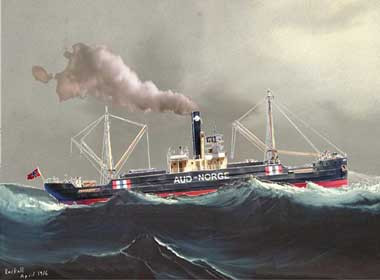
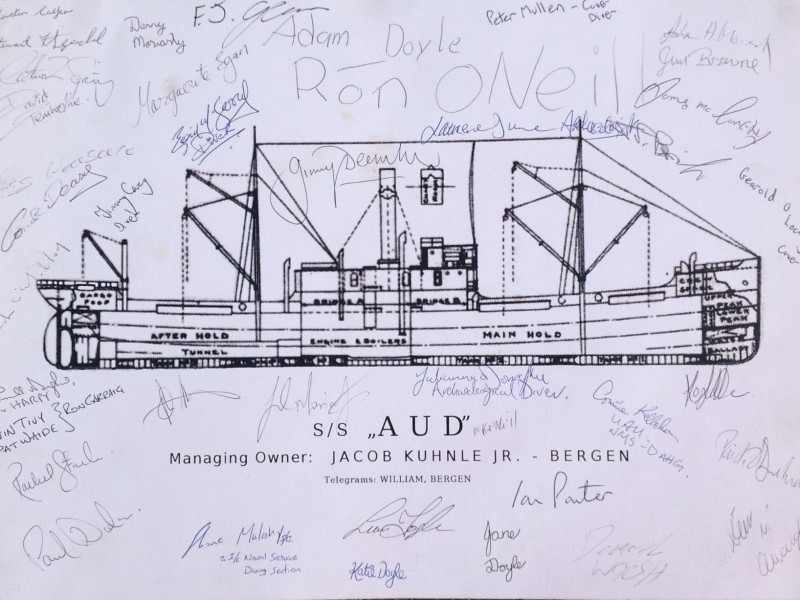
The AUD arrived in Tralee Bay on the Thursday in the late afternoon, and loitered between Fenit and the Maherees for nearly twenty-four hours waiting for the agreed signal from the Irish pilot’s son, Mort O’Leary. Mort actually saw the ship but not expecting it until Sunday did not register its significance. Captain Spindler also failed to make any contact with Casement’s submarine.
The ship departed but not before being boarded by a Royal Navy armed trawler, SETTER II, which failed to notice the fake Norwegian crew and the cargo of arms under open hatches, and instead provided Spindler with up-to-date newspapers. Intent on staying for a while longer, the approach of a second British ship made Spindler take off. The Navy version of the Setter incident was a “bare mention of some kind of encounter” which suggests embarrassment on the part of Sir Lewis Bayly, the Queenstown Admiral, who, almost alone in Ireland, knew exactly what he was looking for as he was privy to the deciphered German messages about the Rising. (Dublin Castle was not told with enormous consequences).
Admiralty anchor on AUD wreck. Photo courtesy of Timmy Carey, Fermoy.
A small flotilla of boats was at the scene on the day.
AUD admiralty anchor coming aboard the Rón Carrig
Preparing to bring AUD's stockless anchor to the surface.
We had the pleasure of having Capt. Michael Coleman aboard HARPY with us for some of the day. Now retired, he commanded - amongst others - two of Ireland's tall ships - the "JEANNIE JOHNSON" and the "ASGARD". Appropriately, as he was also a Cork harbour pilot it was fortunate that the Cork pilot-boat "SONIA" steamed into the view.
Some in Cobh will remember Michael building his steel yacht "Stella Maris" in the old RNLI boathouse (now Sea-scout hall) in Cobh between 1984-87. With her he sailed to Iceland, the USSR and many other places. Of course this well-loved Cobh man has sailed many a sailing boat to many, many parts of the world and has many stories to tell.
While it was never though that HARPY would be meeting and dropping the pilot off Cork, life is full of surprises! And I was very proud to be dropping this pilot off.
Not allowing the anchor to dry in the sunlight was critical to its preservation. Archaeologist Julieanne O'Donoghue tends to the anchor.
John Schmidz (left) and Fred Schmidz, grandchildren of AUD crewman Signalman Freidrich Schmidz were here for the raising of the anchors.
John Schmitz made the point that their family crest contains a gold anchor while Fred said that, like the Liberty Bell of his country, the anchors were a symbol of Independance. You can see their comments on RTE at:-
"http://www.rte.ie/news/av/2012/0619/media-3322348.html"
L to R: Lar Dunne, Archaeologist, Cobh Lady Mayoress Sinead Shepherd, Irish Naval Service skipper ? and Eoin McGarry, chief diver.
L to Right: Lar Dunne, Carroll O'Donoghue, ?, Eoin McGarry, Pat Waide, Gavin Tivey,
By now in their crates, preserving chemicals about to be added before water fills the casing. The are nearly ready for the road journey to Tralee for ongoing conservation, which will take roughly 30 months. There is a sufficient time available for them to be ready for the 1916 centenary.
Photo courtesy of Timmy Carey, Fermoy.
Photo - courtesy of Timmy Carey, Fermoy - is of AUD's stockless anchor, still in it's hawse-pipe prior to lifting. It took diver Eoin McGarry a lot of effort to break the anchor loose from the hawse-pipe prior to the day of the lift,
This gun was recovered by my friend John Bennett, (owner of Mother Hubbards Café in Kinsale), sometime in the 1960's and passed on to me in 2022. Unfortunately it was not treated and so much of the metal has corroded now. I believe it is one of a large batch of Russian MOSIN NAGANT M91 rifles/carbines that was originally captured by the Germans from Russia and then shipped via the AUD. (Will try and confirm as time allows.)
This gun was recovered by my friend John Bennett, (owner of Mother Hubbards Café in Kinsale), sometime in the 1960's and passed on to me in 2022. Unfortunately it was not treated and so much of the metal has corroded now. I believe it is one of a large batch of Russian MOSIN NAGANT M91 rifles/carbines that was originally captured by the Germans from Russia and then shipped via the AUD. (Will try and confirm as time allows.)
Roger Casement was amongst the great humanitarian of his time, an Irish patriot, poet, revolutionary and nationalist. He was born in 1864, the son of an Irish Protestant father and a Catholic mother and grew up in County Antrim and Liverpool. As a renowned human rights campaigner, he was knighted in 1911 for his public services exposing the cruelties practised by European traders in Africa and South America. Specifically his work resulted in the end of King Leopold of Belgiums brutal, tyrannical rule of the Belgian Congo and the murder, rape, mutilation of its people and pillage of the land. He then followed that with a similar overthrow of another brutal regime in Peru.
He retired from the colonial service in 1912 and, always of strong nationalist sympathies, joined the Irish Volunteers the following year, taking up the cause of Irish nationalism. He was central to the successful Howth gun running expedition and, though unsuccessful, tried to recruit Irish POWs in Germany to the cause.
Following the AUD from Germany aboard submarine U-19 with the intention of leading the ship in along Tralee Bay, Casement - having landed at Banna Strand - was captured while awaiting link-up with rebels at a ring-fort near Ardfert. He was taken to England where he was tried for his part in the 1916 Easter Rising in August 1916 and hanged at Pentonville prison.
His body was exumed from its limed grave in Pentonville and repatriated to Ireland in 1965. Though Casement wished to be buried in Antrim, the body was release by British PM Harold Wilson on the strict condition that he be buried in the Irish Republic. He received a state funeral, the cortege stopping outside the GPO, Dublin for 1 minute on its way to his final resting place in Glasnevin Cemetery.
By coincidence, the book "The Trial of Sir Roger Casement" (ISBN: 4781290331821) by George H.Knott & Roger Casement was released by HardPress Publishing in 2012 around the time of the raising of these anchors, and received very good reviews.
Roger Casements remains were returned to Ireland in 1966 and interred in Glasnevin cemetery. He had wished to be buried in Antrim, however one condition by PM Harold Wilson before releasing his remains from his Pentonville Prison limed grave was that he be buried in the 26 counties.
And so, Roger Casement was given a full state funeral through Ireland's captial. Along the route, the cortege stopped for 1 minute outside the GPO en route to Glasnevin. A very ill President Éamon de Valera (1882 - 1975)insisted in attending the funeral.
This huge canvas (10' x 7') hangs at Kings Inns, Dublin. By Sir John Lavery it depicts Roger Casement appeal of his death sentence for High Treason at London's Royal Courts of Justice.
Bequeathed to the English by Lavery, the painting was a embarrassment to the Legal authorities and they were glad to pass in off as a permanent loan to Kings Inns, Dublin.
By coincidence, a book "The Trial of Roger Casement" was published in mid 2012.
Click here to open the original 3-page PDF document.
The AUD arrived in Tralee Bay on the Thursday in the late afternoon, and loitered between Fenit and the Maherees for nearly twenty-four hours waiting for the agreed signal from the Irish pilot’s son, Mort O’Leary. Mort actually saw the ship but not expecting it until Sunday did not register its significance. Captain Spindler also failed to make any contact with Casement’s submarine.
The ship departed but not before being boarded by a Royal Navy armed trawler, SETTER II, which failed to notice the fake Norwegian crew and the cargo of arms under open hatches, and instead provided Spindler with up-to-date newspapers. Intent on staying for a while longer, the approach of a second British ship made Spindler take off. The Navy version of the Setter incident was a “bare mention of some kind of encounter” which suggests embarrassment on the part of Sir Lewis Bayly, the Queenstown Admiral, who, almost alone in Ireland, knew exactly what he was looking for as he was privy to the deciphered German messages about the Rising. (Dublin Castle was not told with enormous consequences).
Admiralty anchor on AUD wreck. Photo courtesy of Timmy Carey, Fermoy.
A small flotilla of boats was at the scene on the day.
AUD admiralty anchor coming aboard the Rón Carrig
Preparing to bring AUD's stockless anchor to the surface.
We had the pleasure of having Capt. Michael Coleman aboard HARPY with us for some of the day. Now retired, he commanded - amongst others - two of Ireland's tall ships - the "JEANNIE JOHNSON" and the "ASGARD". Appropriately, as he was also a Cork harbour pilot it was fortunate that the Cork pilot-boat "SONIA" steamed into the view.
Some in Cobh will remember Michael building his steel yacht "Stella Maris" in the old RNLI boathouse (now Sea-scout hall) in Cobh between 1984-87. With her he sailed to Iceland, the USSR and many other places. Of course this well-loved Cobh man has sailed many a sailing boat to many, many parts of the world and has many stories to tell.
While it was never though that HARPY would be meeting and dropping the pilot off Cork, life is full of surprises! And I was very proud to be dropping this pilot off.
Not allowing the anchor to dry in the sunlight was critical to its preservation. Archaeologist Julieanne O'Donoghue tends to the anchor.
John Schmidz (left) and Fred Schmidz, grandchildren of AUD crewman Signalman Freidrich Schmidz were here for the raising of the anchors.
John Schmitz made the point that their family crest contains a gold anchor while Fred said that, like the Liberty Bell of his country, the anchors were a symbol of Independance. You can see their comments on RTE at:-
"http://www.rte.ie/news/av/2012/0619/media-3322348.html"
L to R: Lar Dunne, Archaeologist, Cobh Lady Mayoress Sinead Shepherd, Irish Naval Service skipper ? and Eoin McGarry, chief diver.
L to Right: Lar Dunne, Carroll O'Donoghue, ?, Eoin McGarry, Pat Waide, Gavin Tivey,
By now in their crates, preserving chemicals about to be added before water fills the casing. The are nearly ready for the road journey to Tralee for ongoing conservation, which will take roughly 30 months. There is a sufficient time available for them to be ready for the 1916 centenary.
Photo courtesy of Timmy Carey, Fermoy.
Photo - courtesy of Timmy Carey, Fermoy - is of AUD's stockless anchor, still in it's hawse-pipe prior to lifting. It took diver Eoin McGarry a lot of effort to break the anchor loose from the hawse-pipe prior to the day of the lift,
This gun was recovered by my friend John Bennett, (owner of Mother Hubbards Café in Kinsale), sometime in the 1960's and passed on to me in 2022. Unfortunately it was not treated and so much of the metal has corroded now. I believe it is one of a large batch of Russian MOSIN NAGANT M91 rifles/carbines that was originally captured by the Germans from Russia and then shipped via the AUD. (Will try and confirm as time allows.)
This gun was recovered by my friend John Bennett, (owner of Mother Hubbards Café in Kinsale), sometime in the 1960's and passed on to me in 2022. Unfortunately it was not treated and so much of the metal has corroded now. I believe it is one of a large batch of Russian MOSIN NAGANT M91 rifles/carbines that was originally captured by the Germans from Russia and then shipped via the AUD. (Will try and confirm as time allows.)
Roger Casement was amongst the great humanitarian of his time, an Irish patriot, poet, revolutionary and nationalist. He was born in 1864, the son of an Irish Protestant father and a Catholic mother and grew up in County Antrim and Liverpool. As a renowned human rights campaigner, he was knighted in 1911 for his public services exposing the cruelties practised by European traders in Africa and South America. Specifically his work resulted in the end of King Leopold of Belgiums brutal, tyrannical rule of the Belgian Congo and the murder, rape, mutilation of its people and pillage of the land. He then followed that with a similar overthrow of another brutal regime in Peru.
He retired from the colonial service in 1912 and, always of strong nationalist sympathies, joined the Irish Volunteers the following year, taking up the cause of Irish nationalism. He was central to the successful Howth gun running expedition and, though unsuccessful, tried to recruit Irish POWs in Germany to the cause.
Following the AUD from Germany aboard submarine U-19 with the intention of leading the ship in along Tralee Bay, Casement - having landed at Banna Strand - was captured while awaiting link-up with rebels at a ring-fort near Ardfert. He was taken to England where he was tried for his part in the 1916 Easter Rising in August 1916 and hanged at Pentonville prison.
His body was exumed from its limed grave in Pentonville and repatriated to Ireland in 1965. Though Casement wished to be buried in Antrim, the body was release by British PM Harold Wilson on the strict condition that he be buried in the Irish Republic. He received a state funeral, the cortege stopping outside the GPO, Dublin for 1 minute on its way to his final resting place in Glasnevin Cemetery.
By coincidence, the book "The Trial of Sir Roger Casement" (ISBN: 4781290331821) by George H.Knott & Roger Casement was released by HardPress Publishing in 2012 around the time of the raising of these anchors, and received very good reviews.
Roger Casements remains were returned to Ireland in 1966 and interred in Glasnevin cemetery. He had wished to be buried in Antrim, however one condition by PM Harold Wilson before releasing his remains from his Pentonville Prison limed grave was that he be buried in the 26 counties.
And so, Roger Casement was given a full state funeral through Ireland's captial. Along the route, the cortege stopped for 1 minute outside the GPO en route to Glasnevin. A very ill President Éamon de Valera (1882 - 1975)insisted in attending the funeral.
This huge canvas (10' x 7') hangs at Kings Inns, Dublin. By Sir John Lavery it depicts Roger Casement appeal of his death sentence for High Treason at London's Royal Courts of Justice.
Bequeathed to the English by Lavery, the painting was a embarrassment to the Legal authorities and they were glad to pass in off as a permanent loan to Kings Inns, Dublin.
By coincidence, a book "The Trial of Roger Casement" was published in mid 2012.
Click here to open the original 3-page PDF document.
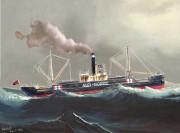
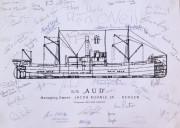

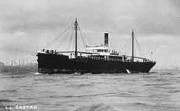
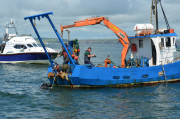
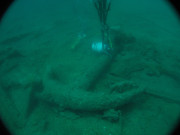
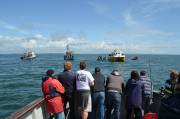
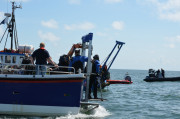
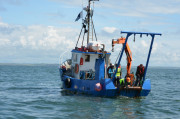
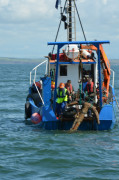
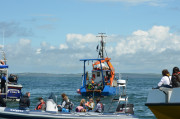
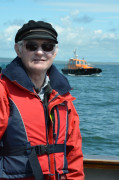
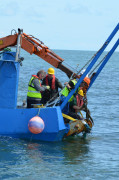
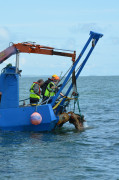

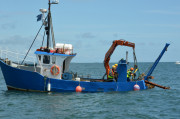
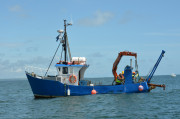
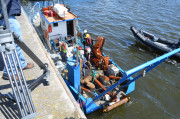
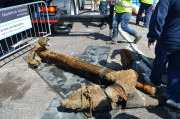
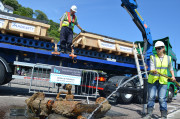
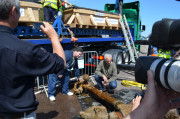
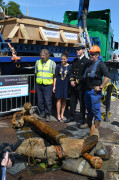
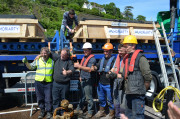


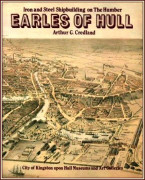
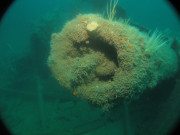


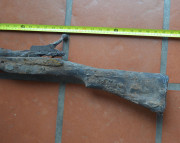
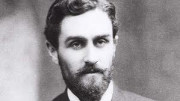
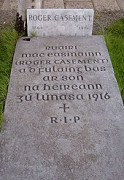
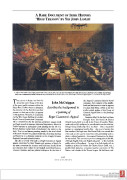
|
|
|
|